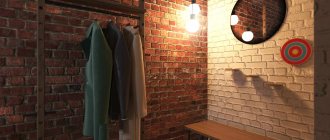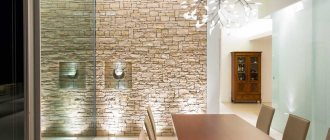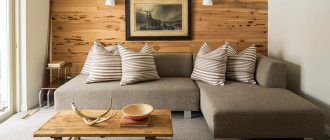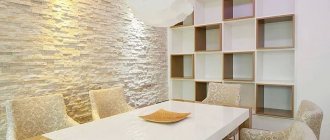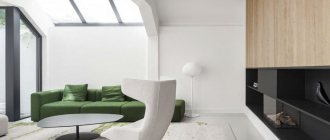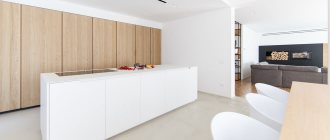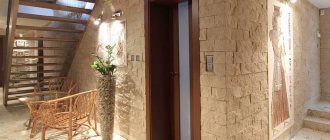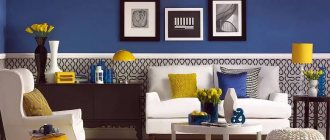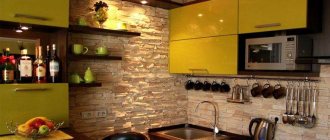When looking for an original option for decorating the main room in the house - the hall - it is worth taking a closer look at the analogue of sedimentary rocks. Artificial stone in the interior of the living room can act as a monolithic decoration of walls, ceilings or small inclusions in the form of panels, decorative inserts, cladding of a fireplace portal or columns.
Decorating the living room with decorative stone
Innovations in the production of finishing materials have achieved incredible success. Composites and agglomerates are extremely difficult to distinguish from granite, onyx or marble created by nature. Their color, shape and texture identically imitate genuine layered rocks with torn edges and relief texture. This is achieved through microcomponents that perfectly accurately copy natural samples, creating similar relief by using forms with typical outlines.
Decorating the living room with decorative stone
In terms of performance properties, this finishing material is significantly superior to exotic sedimentary rocks. Artificial stone of various colors and shapes in the interior of the living room will create an unrivaled atmosphere that gives the feeling of being in nature.
Decorating the living room with decorative stone
Artificial stone in the living room interior: variations of use
Decorating the living room with decorative stone
Composites and agglomerates are distinguished not only by their aesthetic beauty, but also by their impeccable practicality. Unlike wallpaper or paint, often used to decorate a room, artificial stone does not change its original color when exposed to direct sunlight and is extremely resistant to abrasion. That’s why it is so often used when decorating different parts of the hall:
- Framing door, window openings, arches. Due to high traffic, door slopes quickly lose their original appearance and require replacement. Because of this, it is wise to make an arched entrance to the living room using imitation rocks. If you use quartz agglomerate, you will be able to create an impressive-looking monumental doorway that can look like the main asset of the decoration of the hall for many decades. In terms of hardness, it is slightly inferior to the hardest stone in the world - diamond. Quartz agglomerate is extremely difficult to deform or scratch, which is especially important for entrance and passage areas in the house.
- Cladding accent walls. This part of the volumetric-spatial composition acts as a focal point, concentrating the attention of others. This is the best place to use stone in the living room. Photos of the design of accent walls using proportional masonry or in the form of a shapeless finish similar to natural rocks will help give a majestic look to the main dominant feature of the interior of the room.
- Design of corners, ceiling and floor skirting boards. Framing the walls, ceiling and floor from artificial stone will create an effect of depth and emphasize the primacy of the natural component in the living room interior design concept.
Decorating the living room with decorative stone
A dynamic visual effect is created by artificial cast, concrete, gypsum stone with thin veins or granular inclusions. Therefore, it is reasonable to use it to create basic accents in an interior painting with intricate architectural forms.
Decorating the living room with decorative stone
Photo ideas for decorating living room walls with stone
If you notice an error, video or link that doesn't work, please select a piece of text and click Ctrl+Enter.
0
Design solutions for the use of artificial stone in the living room interior
It is customary to decorate the walls in the representative area with paintings, photo frames, handicrafts and other decorative items. The perfect background will be stone cladding with a natural color - graphite, brown, brown and its many gradations. If the interior decorations have many small details, then you should give preference to large-format tiles made of decorative stone. Against such a background, it is comfortable to examine the execution of decorative items in detail.
Decorating the living room with decorative stone
The natural aura created by artificial stone in the interior of the living room can be supported by an abundance of indoor plants in floor pots and hanging planters, paintings with pastoral scenes, and homemade products made from natural materials. Imitations of finishing made from sea pebbles, shell rock or river sand organically echo aquariums, florariums, cages with birds or exotic animals.
Decorating the living room with decorative stone
If in a spacious hall of a country house you can safely decorate all parts of the room with decorative stone with a voluminous, pronounced relief, then for a living room in an apartment this is an extremely unsuitable option for covering the walls and floor. A large-looking finish will significantly reduce the free space in the room where it is customary to welcome guests. For narrow and small rooms, you need to select types of decorative stone with a perfectly polished, smooth surface and light color.
Decorating the living room with decorative stone
Various methods of fragmentary laying of artificial stone in the living room are welcome. Photos of figured wall decoration clearly demonstrate the variety of ways to highlight accentual notes in an interior painting. Stone edging on the wall can be used to surround interesting clocks, animal antlers, antique wall candlesticks, shelves with souvenirs brought from distant countries, and many other things worthy of everyone’s attention.
Decorating the living room with decorative stone
Where to use?
Artificial stone is so versatile that it can be used to decorate all types of surfaces in the living room. Today, most apartment owners prefer to decorate arches and doorways with this material. For a classic style, cladding columns with stone is well suited. Often in modern living room designs you can find small fountains or waterfalls. Such designs will be a win-win in combination with products that imitate natural materials.
Compositions made of stone walls and wrought iron railings also deserve special attention. In this case, the walls can be decorated with artificial elements in the form of stripes or panels. The main element in the interior of most living rooms is the fireplace. Facing it with stone will highlight the beauty of the structure against the general background of the room, and floors made of such material will make the room stylish and chic.
In small living rooms, you can decorate the bar counter with stone. This design method will allow you to visually delimit the space and make the room comfortable.
Modifications of artificial stone
Just a few decades ago, stone decoration decorated only the facades of houses and was extremely rare in luxury apartments. Today, affordable and easy-to-use composite materials are often used by designers for cladding not only the walls, ceiling or floor of the living room. Artificial stone in the interior of the hall is used for the manufacture of furniture parts, architectural and decorative elements. It is important to understand which type of stone is best suited for various design tasks:
- Acrylic composite material is characterized by high hardness, strength, and resistance to mechanical stress. It is widely used in the production of tabletops for chests of drawers, consoles, secretaries, coffee tables, TV stands and other elements of living room sets. It is worth noting that furniture frames and bases are made from similar types of stone, which can withstand the high load of heavy tabletops.
- Decorative cast marble has unsurpassed performance properties. Its strength is surpassed only by natural stones: granite, marble, quartzite, slate, travertine. This artificial stone is found in the living room as the basis of monolithic window sills, mantelpieces and portals. The cold emanating from snow-white marble with black veins should be offset by curtains made of weightless fabric and decorative items in warming sunny colors.
- Artificial concrete bricks, pebbles, and agglomerate based on quartz granules are ideal for decorating walls in the living room. To perform facing work, they are produced in the form of large-format slabs. This allows you to create a seamless wall covering. Solid stone panels on the walls not only look majestic, but are also extremely convenient to use. The perfectly smooth surface is easy to clean. The absence of pores and seams eliminates the likelihood of the formation of fungi, mold, and dust accumulation.
- If you have an idea to organize a decorative fountain, then it is difficult to choose a better facing material for its framing than an acrylic composite with a resin base with the addition of mineral fillers and organic dyes. It is famous for its excellent waterproofness and wear resistance.
Decorating the living room with decorative stone
To prevent the granite floor or stone wall in the living room from creating the feeling of being in a dark cave, it is advisable to pay special attention to the selection of wide-format window profiles and the organization of multi-level lighting. A well-thought-out lighting system created by different light sources is relevant for a room with stone decoration and furniture. The general atmosphere prevailing in the living room with monumental furnishings and decoration depends on this.
How to decorate?
Decorating a wall in the living room is a responsible task and not as simple as it might seem at first glance. Decorations on the wall can be combined with the color of the furniture and the rest of the furnishings in the room, or they can contrast with them and stand out from the interior.
The wall in the living room can be decorated in several ways:
- tapestry;
- paintings;
- family tree;
- panels made of ceramics or wood;
- various handmade things;
- wall painting;
- ornaments;
- modular picture;
- photo frames and photo collages;
- stickers and other accessories;
- Children's drawings.
In many ways, the decorations depend on the style in which the hall is decorated:
- If the interior of the room is classic and there is a fireplace, then the space above it can be decorated with a tapestry or carpet. The empty space above the sofa or TV is decorated with paintings by famous artists or a mirror in an antique frame. To decorate the walls, you can use stucco decorations and panels made of valuable wood. It's a good idea to display a family tree on the wall.
- To decorate a room in a rustic style, panels made of wood or ceramics, as well as handmade items, are suitable. They will make the interior more homely and cozy.
- Provence is interesting because it combines elements of both rustic and urban styles, therefore it is universal and suitable for different rooms. When decorating the living room, natural materials are used, such as wood. Wallpaper with a voluminous pattern or horizontal wide stripes will look good. The wall will be decorated with ceramic panels with ornaments and wall paintings.
- Eclecticism involves mixing several styles and is suitable for a small living room that the owners want to turn into a relaxation room. To decorate the wall, you can use photo wallpapers, 3D panels and modular paintings. A distinctive feature of the latter is that several paintings located at some distance from each other are combined into a single composition. The overall style of the living room can be enhanced with photo frames and photo collages.
- If the living room is decorated in a retro style, then to decorate the wall you can use various things associated with childhood and the past: hang posters with your favorite artists or film actors, make inscriptions, attach stickers and other accessories. You can use children's photographs in the interior.
We advise you to study - Design of walls with laminate in the interior of different rooms
- Japanese style is restrained and involves a minimum of details. For decoration, you can use modular paintings depicting birds and trees or paint them yourself.
- Like the Japanese style, minimalism is not characterized by a large amount of furniture and decor. Niches and shelves made of plasterboard made in the wall are perfect here.
- Glamorous style is suitable for bold and modern people. It combines an abundance of bright colors, gloss and unusual interior items. Mirror surfaces and mirror compositions are often used for wall decoration.
Distinctive features of decorative stone
Decorating the living room with decorative stone
Depending on the composition of the microcomponents, the method of firing and processing, artificial stone looks completely different, which allows it to be used for different purposes when decorating the interior of the living room:
- Porcelain tiles are made from spar, organic elements, and clay. At the final stage of processing, the stone slabs are ground, polished, and glazed. Samples with a matte surface are preferably used as floor coverings, and those with a smooth surface are used for finishing walls and window spaces.
- Decorative stone made of colored concrete can have any color. Designers often cover walls with multi-colored elements in order to maintain color balance with the palette of surrounding furnishings. Reinforced concrete slabs with a natural grayish-whitish color in the form of genuine boulders and cobblestones are widely used for wall decoration, imitating the appearance of living rooms in ancient houses, where the spirit of antiquity reigns and a homely hearth is always present.
- Clinker tiles are a type of artificial stone produced in the form of panels to recreate the look of brickwork. Ideally even layouts of clinker tiles look original both in the fireplace area and on an accent wall in tandem with a thin TV screen.
Decorating the living room with decorative stone
In addition to its visual appeal, this finishing material is characterized by impeccable properties:
- Due to its light weight, it puts minimal load on the walls. It can be used to design interior partitions not only from concrete, but also from plasterboard.
- High levels of strength and resistance to mechanical stress determine long-term service life. If a microcrack or chip appears on a stone surface, the flaw can be easily masked by piecemeal replacement of the deformed elements.
- Due to its excellent fire resistance, it is actively used to decorate the portal, chimney and other parts of the fireplace area.
Decorating the living room with decorative stone
Rules for combining artificial stone with interior items
Decorating the living room with decorative stone
The design of the living room calls for creating a harmonious picture of the interior, where it is comfortable to be alone or in the company of friends or relatives. You can cope with this task perfectly if you choose the right companions for stone finishing:
- If you plan to finish corners or baseboards using composites or agglomerates, you should definitely install spotlights on the ceiling or use recessed spotlights to illuminate the floor. Spots with metal shades, unlike polymers, are organically combined with stone decor.
- If imitation marble or granite is used to cover the floor, then the carpets should be woven from natural raw materials - wool, cotton, silk. A harmonious tandem will be obtained from stone flooring and animal skins, laid out near the fireplace insert or sofa group.
Decorating the living room with decorative stone
Artificial stone can appear not only in the lining of the living room, but also when decorating it. Plastic agglomerates, unlike natural analogues, easily take any desired shape. Taking advantage of this property, designers have found widespread use of stone in the living room. Photos of wall and table clocks, picture and mirror frames, figurines, vases, boxes, lamp shades and floor lamps with artificial stone inserts inspire you to create an original decoration for the main room in the house. Creatively designed accessories look expressive against a plain background: a wall or table top.
Decorating the living room with decorative stone
Varieties of decorative product
Production facilities at modern factories allow us to produce all kinds of construction products. Just like appearance, the composition of different types of material differs, which directly affects its properties. Among the main players in the market, the following types of decorative finishing stones stand out:
- Porcelain tiles. The characteristics of this type allow it to be used for finishing external facades. The composition of porcelain tiles includes feldspar, high-quality clay, and dyes. The manufacturing process involves pressing and firing of the material. The consequences of such processing are the high strength of the product and its moisture resistance. It becomes possible to use tiles to cover the walls of a shower room. Uniform coloring is ensured due to a uniform structure throughout the entire depth of the sample. The factory assortment offers users various geometric shapes of tiles, colors (matte or gloss), texture features (polished or rough). The section shows the same texture as that of natural stone. Porcelain stoneware products can easily withstand temperature changes, but they should not be exposed to chemical influences.
Wall decoration with light decorative stone in the dining room
- Agglomerates. Decorating the hallway with decorative stone made from agglomerates very accurately imitates the external properties of natural elements in nature. For their production, a special filler (granite chips, quartz sand), an adhesive binder (polyester resin) and pigment dyes are used. Quartz agglomerates have earned the most popularity, as they are distinguished by their durability and elegant appearance. The hardness of the product allows it to be used for finishing external facades.
- Products based on concrete or gypsum.
Decorative stone on a bedroom wall with a combination of painted walls
Despite the attractiveness of the previous types, the most common building materials are still concrete and gypsum. The production technology gives sand-cement products a sufficiently high strength that allows them to be used for finishing hallways. The properties of gypsum and concrete materials are somewhat different:
- Gypsum stone can be processed using hand tools, concrete stone can be cut with a grinder;
- Gypsum samples are two times lighter than concrete ones, which allows them to be installed on drywall;
- The smooth surface of concrete stones decorates exterior walls better than plaster;
- The cost of gypsum products is slightly less compared to concrete material.
Bar counter and large stone
Despite all the differences, the manufacturing technology for these materials is the same: pouring into geometric shapes.
Stone wall in the living room
Combination of stone and dark wallpaper for painting
The role of artificial stone in the interior of a living room with a variable stylistic concept
Each type of artificial stone has unique features that allow you to create a unique interior in any desired design style:
- The monumental appearance of decorative marble will reflect the aesthetics of classical and historical trends in design art: Empire, Baroque, Rococo, Art Deco.
- Acrylic stones with an impeccably smooth and dazzling mirror-like surface easily embody modern trends in interior fashion: high-tech, modern, industrial style and many others.
- To give the interior of the living room an antique look in the spirit of vintage, retro or antique design style, it is advisable to use artificial stone with an uneven concrete base with an aging effect. Through sandblasting, patination, the addition of ash, tree bark, sea salt, colored pigments and other components, decorators manage to achieve incredible results when decorating a living room. The surface of decorative stones clearly demonstrates the “imprint of time”: weathered whitish spots, a green coating associated with moss, a smooth base symbolizing the influence of sea tides over many millennia.
- The best solution for furnishing a room in the Provence style would be to install a soft sofa group, upholstered in light fabric with a floral print, in tandem with a snow-white acrylate coffee table. This decorative stone is characterized by excellent durability. It is used to produce cast countertops of various configurations without a single seam. For the romantic Provence that dominates the interior of the living room, it is optimal to use agglomerates for decoration with imitation of wildflowers, frozen, as if under ice, under a layer of transparent glaze.
- The interiors of living rooms, designed in ethnic styles (Moroccan, African, oriental), are impressed by the partial decoration of the walls with large stones with a pronounced relief of yellow-ocher tones.
- Decorating walls with coarse-grained composites interspersed with particles reminiscent of fragments of fallen leaves, pine needles, and shells will effectively reflect natural motifs in rooms with the concept of rustic, country, chalet, and Scandinavian design style.
Decorating the living room with decorative stone
Thanks to the huge number of modifications of decorative stone with different sizes, shapes, colors and textures for almost every interior genre, you can choose the optimal type for decoration or decoration.
Decorating the living room with decorative stone
And in the chronicles of ancient Russian architecture, and in modern architecture, and in the trends of design art, stone actively appears in the interior of the living room. Photos of the diverse options for using composites and agglomerates with natural shapes and shades in decorating a room provoke a preference for finishing materials that have been used for centuries.
Decorating the living room with decorative stone
If you want to create a beneficial aura for complete mental relaxation, it is reasonable to use artificial stone, which has an amazing resemblance to its natural counterparts, to decorate the living room interior.
